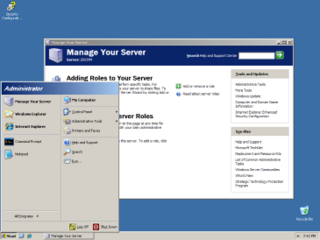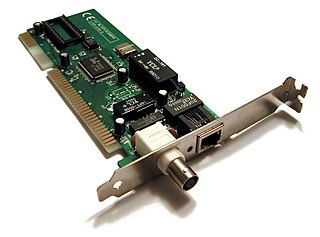Microsoft Windows was announced by Bill Gates on November 10, 1983. Microsoft introduced Windows as a graphical user interface for MS-DOS, which had been introduced two years earlier. The product line evolved in the 1990s from an operating environment into a fully complete, modern operating system over two lines of development, each with their own separate codebase.

Windows 2000 is a major release of the Windows NT operating system developed by Microsoft and designed for businesses. It was the direct successor to Windows NT 4.0, and was released to manufacturing on December 15, 1999, and was officially released to retail on February 17, 2000 and September 26, 2000 for Windows 2000 Datacenter Server. It was Microsoft's business operating system until the introduction of Windows XP Professional in 2001.
Internet Small Computer Systems Interface or iSCSI is an Internet Protocol-based storage networking standard for linking data storage facilities. iSCSI provides block-level access to storage devices by carrying SCSI commands over a TCP/IP network. iSCSI facilitates data transfers over intranets and to manage storage over long distances. It can be used to transmit data over local area networks (LANs), wide area networks (WANs), or the Internet and can enable location-independent data storage and retrieval.

Windows Server 2003, codenamed "Whistler Server", is the second version of Windows Server operating system produced by Microsoft. It is part of the Windows NT family of operating systems and was released to manufacturing on March 28, 2003 and generally available on April 24, 2003. Windows Server 2003 is the successor to the Server editions of Windows 2000 and the predecessor to Windows Server 2008. An updated version, Windows Server 2003 R2, was released to manufacturing on December 6, 2005. Windows Server 2003 is based on the consumer operating system, Windows XP.

A network interface controller is a computer hardware component that connects a computer to a computer network.
Server Message Block (SMB) is a communication protocol originally developed in 1983 by Barry A. Feigenbaum at IBM and intended to provide shared access to files and printers across nodes on a network of systems running IBM's OS/2. It also provides an authenticated inter-process communication (IPC) mechanism. In 1987, Microsoft and 3Com implemented SMB in LAN Manager for OS/2, at which time SMB used the NetBIOS service atop the NetBIOS Frames protocol as its underlying transport. Later, Microsoft implemented SMB in Windows NT 3.1 and has been updating it ever since, adapting it to work with newer underlying transports: TCP/IP and NetBT. SMB over QUIC was introduced in Windows Server 2022. SMB implementation consists of two vaguely named Windows services: "Server" and "Workstation". It uses NTLM or Kerberos protocols for user authentication.

NetWare is a discontinued computer network operating system developed by Novell, Inc. It initially used cooperative multitasking to run various services on a personal computer, using the IPX network protocol.
Remote Desktop Protocol (RDP) is a proprietary protocol developed by Microsoft Corporation which provides a user with a graphical interface to connect to another computer over a network connection. The user employs RDP client software for this purpose, while the other computer must run RDP server software.
TCP offload engine (TOE) is a technology used in some network interface cards (NIC) to offload processing of the entire TCP/IP stack to the network controller. It is primarily used with high-speed network interfaces, such as gigabit Ethernet and 10 Gigabit Ethernet, where processing overhead of the network stack becomes significant. TOEs are often used as a way to reduce the overhead associated with Internet Protocol (IP) storage protocols such as iSCSI and Network File System (NFS).

Windows NT 3.51 is a major release of the Windows NT operating system developed by Microsoft and oriented towards businesses. It is the third version of Windows NT and was released on May 30, 1995, eight months following the release of Windows NT 3.5. The most significant enhancement offered in this release was that it provides client/server support for inter-operating with Windows 95, which was released almost three months after NT 3.51. Windows NT 4.0 became its successor a year later. Mainstream support for Windows NT 3.51 Workstation ended on December 31, 2000, and extended support ended on December 31, 2001, while Windows NT 3.51 Server mainstream support ended on September 30, 2000, followed by extended support on September 30, 2002. Both editions were succeeded by Windows NT 4.0 Workstation and Windows NT 4.0 Server, respectively.
In computing, remote direct memory access (RDMA) is a direct memory access from the memory of one computer into that of another without involving either one's operating system. This permits high-throughput, low-latency networking, which is especially useful in massively parallel computer clusters.
Alacritech was a Silicon Valley company which marketed "intelligent" network interface controllers (NICs) to offload TCP/IP processing from the CPU of computer systems to dedicated hardware on the NIC: a concept now known as a TCP offload engine (TOE). Later it manufactured storage network products. Alacritech's main products were the ANX 1500 series of network throughput acceleration appliances.

Microsoft Forefront Threat Management Gateway, formerly known as Microsoft Internet Security and Acceleration Server, is a discontinued network router, firewall, antivirus program, VPN server and web cache from Microsoft Corporation. It ran on Windows Server and works by inspecting all network traffic that passes through it.
X-Video Motion Compensation (XvMC), is an extension of the X video extension (Xv) for the X Window System. The XvMC API allows video programs to offload portions of the video decoding process to the GPU video-hardware. In theory this process should also reduce bus bandwidth requirements. Currently, the supported portions to be offloaded by XvMC onto the GPU are motion compensation and inverse discrete cosine transform (iDCT) for MPEG-2 video. XvMC also supports offloading decoding of mo comp, iDCT, and VLD for not only MPEG-2 but also MPEG-4 ASP video on VIA Unichrome hardware.
Windows Media Services (WMS) is streaming media server software from Microsoft that allows a Windows Server administrator to generate streaming media (audio/video). Only Windows Media, JPEG, and MP3 formats are supported. WMS is the successor of NetShow Services.
In computing, Microsoft's Windows Vista and Windows Server 2008 introduced in 2007/2008 a new networking stack named Next Generation TCP/IP stack, to improve on the previous stack in several ways. The stack includes native implementation of IPv6, as well as a complete overhaul of IPv4. The new TCP/IP stack uses a new method to store configuration settings that enables more dynamic control and does not require a computer restart after a change in settings. The new stack, implemented as a dual-stack model, depends on a strong host-model and features an infrastructure to enable more modular components that one can dynamically insert and remove.
The Microsoft Java Virtual Machine (MSJVM) is a discontinued proprietary Java virtual machine from Microsoft. It was first made available for Internet Explorer 3 so that users could run Java applets when browsing on the World Wide Web. It was the fastest Windows-based implementation of a Java virtual machine for the first two years after its release. Sun Microsystems, the creator of Java, sued Microsoft in October 1997 for incompletely implementing the Java 1.1 standard. It was also named in the United States v. Microsoft Corp. antitrust civil actions, as an implementation of Microsoft's "Embrace, extend and extinguish" strategy. In 2001, Microsoft settled the lawsuit with Sun and discontinued its Java implementation.
Windows NT is a proprietary graphical operating system produced by Microsoft, the first version of which was released on July 27, 1993. It is a processor-independent, multiprocessing and multi-user operating system.
I/O Acceleration Technology (I/OAT) is a DMA engine by Intel bundled with high-end server motherboards, that offloads memory copies from the main processor by performing direct memory accesses (DMA). It is typically used for accelerating network traffic, but supports any kind of copy.
The Intel Cache Acceleration Software (CAS) is a computer data storage product for solid-state drive (SSD) caching.





